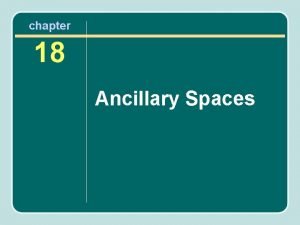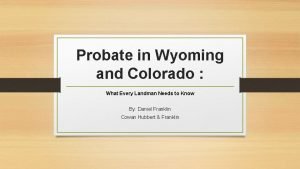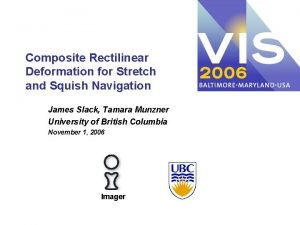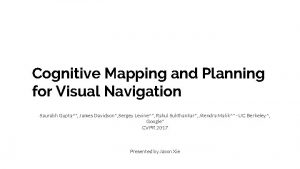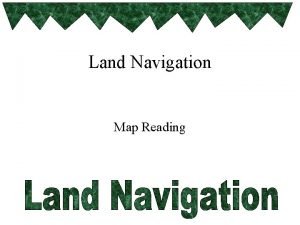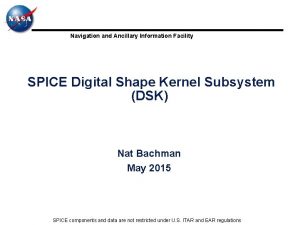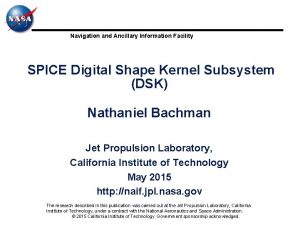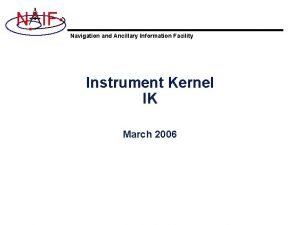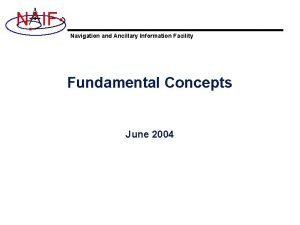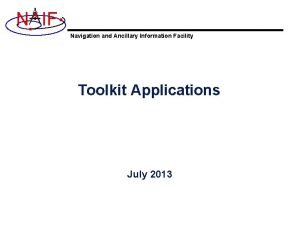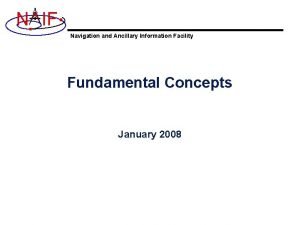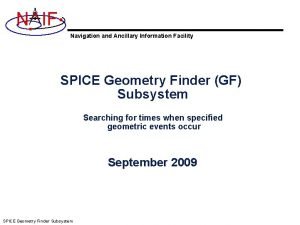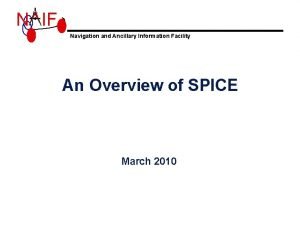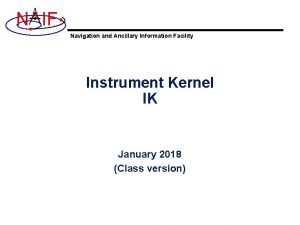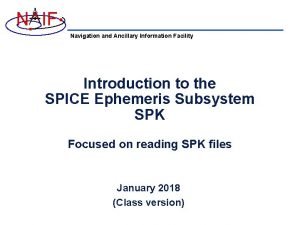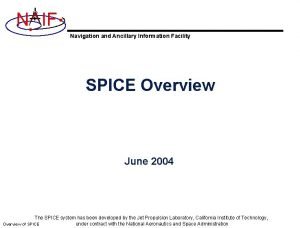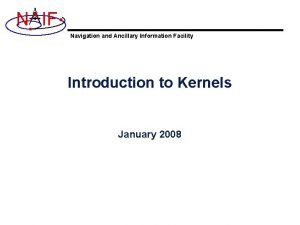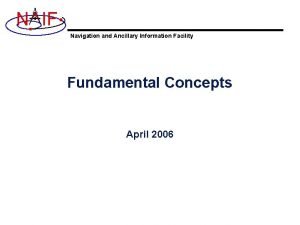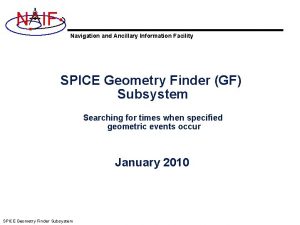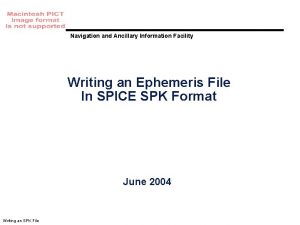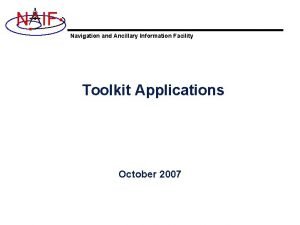N IF Navigation and Ancillary Information Facility Digital






















- Slides: 22

N IF Navigation and Ancillary Information Facility Digital Shape Kernel Subsystem (DSK) January 2018 (Class version)

N IF Topics Navigation and Ancillary Information Facility • • DSK subsystem overview DSK shape representations N 66 version of DSK subsystem DSK APIs and graphical depictions DSK API example DSK utility programs DSK concepts Writing and using DSK files Digital Shape Kernel 2

N IF DSK Subsystem Overview Navigation and Ancillary Information Facility • The DSK subsystem: – enables SPICE-based applications to conveniently make use of surface shape (topographic) data in geometry computations – serves as a format for transmission and archival of surface shape data – consists of SPICE software, DSK file format specifications, and documentation Digital Shape Kernel 3

N IF DSK Shape Representations Navigation and Ancillary Information Facility • The DSK subsystem handles two representations of shape data – Tessellated plate model – Digital elevation model (development not yet finished) • DSK supplements the tri-axial ellipsoid shape model Digital Shape Kernel 4

N IF Tessellated Plate Model Navigation and Ancillary Information Facility • The surface of the object is represented as a collection of triangular plates • More flexible than digital elevation model: any arbitrary 3 -D surface can be modeled – Surface could be a complicated shape with multiple surface points having the same latitude and longitude » Examples: “dumbbell”-shaped asteroid, caves, arches • Less efficient than digital elevation model of similar resolution in terms of storage and computational speed Phobos Digital Shape Kernel Itokowa Churyumov-Gerasimenko 5

N IF Digital Elevation Model Navigation and Ancillary Information Facility • Maps longitude/latitude to “elevation” – Elevation of a surface point can be defined as distance from the origin of a body-fixed reference frame – Elevation of a surface point can be defined as height above a reference ellipsoid • Example: rendering of a piece of DSK data created from MGS laser altimeter (MOLA) Mars DEM Digital Shape Kernel 6

N IF N 66 Toolkit with DSK Navigation and Ancillary Information Facility • Supports only the tessellated plate model data type (Type 2 DSK) • DEM support (Type 4) will be added in a future Toolkit version Digital Shape Kernel 7

N IF Some DSK Features Navigation and Ancillary Information Facility • Supports multi-segment, multi-file DSK data sets – Up to 5000 DSK files can be loaded simultaneously • Supports run-time data translation: big-endian DSK files can be read on little-endian platforms, and vice versa Digital Shape Kernel 8

N IF N 66 DSK APIs Navigation and Ancillary Information Facility • Kernel load/unload/info: – FURNSH, UNLOAD, KCLEAR, KTOTAL, KINFO, KDATA • Geometry: – – – – Ray-surface intercept: SINCPT, DSKXV, DSKXSI Sub-observer point: SUBPNT Sub-solar point: SUBSLR Illumination angles at surface point: ILLUMF, ILLUMG, ILUMIN Longitude-latitude grid to surface points: LATSRF Find occultation state at a given time: OCCULT Find occultation or transit of point target behind/across DSK shape: GFOCLT – Generate limb points: LIMBPT – Generate terminator points: TERMPT – Compute outward normal vector at surface point: SRFNRM • Create DSK files: – DSKOPN, DSKW 02, DSKCLS, DSKMI 2, DSKRB 2 • Summary routines: – DSKOBJ, DSKSRF Digital Shape Kernel 9

N IF Graphic Depictions Navigation and Ancillary Information Facility • In the next several charts we provide graphic depictions of some of the high-level APIs that should be of interest to many users – See the on-line version of this tutorial for a complete summary Digital Shape Kernel 10

N IF Plate Model Surface Intercept Navigation and Ancillary Information Facility API: SINCPT Intercept nearest to observer’s location Additional intercepts ---not computed Input ray Observer’s location Observer is external to object Digital Shape Kernel 11

N IF Plate Model Sub-observer Point Navigation and Ancillary Information Facility API: SUBPNT Reference ellipsoid Sub-observer point (nadir definition) Observer to sub-observer point vector (nadir definition) Sub-observer point (target center definition) Observer to sub-observer point vector (target center definition) Digital Shape Kernel Outward normal to reference ellipsoid Observer location 12

N IF Plate model Illumination Angles Navigation and Ancillary Information Facility API: ILLUMF Outward surface normal Direction to illumination source Phase angle Direction to observer Emission angle Incidence angle Also returned: target epoch (corrected for light time), observer visibility flag, illumination source visibility flag Digital Shape Kernel 13

N IF Plate Model Limb-1 Navigation and Ancillary Information Facility API: LIMBPT Limb point---lies on a tangent ray in the selected half-plane (for some shapes, multiple tangents will exist for a given Ray emanating from observer and tangent to target body Specified half-plane bounded by observertarget center line (axis): contains ray axis and half-plane). Limb point angle relative to axis Observer location Digital Shape Kernel Axis: observer-target center vector 14

N IF Plate Model Terminator-Umbral Navigation and Ancillary Information Facility API: TERMPT Ray tangent to sun and target body Specified half-plane bounded by sun center-target center line (axis): contains ray Umbral terminator point---lies on a tangent ray in the specified half-plane (for some shapes, multiple tangents will exist for a given axis and half- plane). Terminator point and ray vertex are on same side of axis. Sun center Axis: sun center-target center vector Digital Shape Kernel 15

N IF DSK API Example: SINCPT-1 Navigation and Ancillary Information Facility • Find ray intercept point on target surface: – CALL SINCPT ( METHOD, TARGET, FIXREF, ABCORR, OBSRVR, DREF, DVEC, SPOINT, TRGEPC, SRFVEC, FOUND) » SINCPT is a high-level SPICE API present in the (current) N 0065 SPICE Toolkit. » The input string argument METHOD indicates the surface model to use. » To model the target body shape using its reference ellipsoid, set METHOD to ‘ellipsoid’ » To model the target body shape using DSK data, set METHOD to one of the forms • ‘DSK/UNPRIORITIZED’ – If all DSK segments for the body designated by TARGET are applicable • ‘DSK/UNPRIORITIZED/SURFACES = <surface name or ID 1>, …’ – If only DSK segments for the specified surfaces associated with the body designated by TARGET are applicable » For the DSK case, the keyword UNPRIORITIZED is currently required. This keyword indicates that no applicable segment can mask another. Digital Shape Kernel 16

N IF DSK API Example: SINCPT -2 Navigation and Ancillary Information Facility » Other inputs: target body name, epoch, body-fixed reference frame, aberration correction, observer name, reference frame for direction vector, direction vector. » Outputs: ray-surface intercept in Cartesian coordinates, expressed in the body-fixed frame associated with the target--evaluated at the optionally light-time corrected epoch TRGEPC, TRGEPC itself, observer-to-intercept vector expressed in body-fixed frame, and found flag indicating whether intercept exists. Digital Shape Kernel 17

N IF DSK Utility Programs Navigation and Ancillary Information Facility • Create DSK files: MKDSK – Creates a DSK file containing a single type 2 segment • Export DSK data to text format files: DSKEXP – Writes data from type 2 DSK segments to one or more text files – Supports simple output formats such as obj • Summarize DSK files: DSKBRIEF • Merge DSK files: DLACAT – Concatenates segments from multiple DSK files into a single DSK file • Transform binary architecture of DSK file: TOXFR, TOBIN, BINGO (BINGO not part of standard SPICE Toolkit) • Read/write comment area: COMMNT Digital Shape Kernel 18

N IF DSK Concepts-1 Navigation and Ancillary Information Facility • Surface – A second identifier, in addition to the central body » A “surface” has a name and an integer ID code • Surfaces occupy a name space distinct from that of bodies • APIs are provided for surface name/ID conversion – Used to distinguish different versions of data for a given body » Allows use of different versions without loading and unloading kernels • High-frequency kernel loading and unloading is too inefficient for DSK applications • Data class – A “hook” to differentiate kinds of data for different applications » Distinct from concept of “data type” – Existing classes indicate geometric characteristics of surface data » Class 1: shape is single-valued function of domain coordinates. Example, for latitudinal coordinates: • Every ray emanating from the origin of the body-fixed reference frame associated with the body passes through the surface once • Such surfaces cannot have features such as cliffs or caves • DEMs can represent class 1 surfaces » Class 2: arbitrary shape • Not required to be convex, closed, or connected • Plate models are only DSK data type that can be used for class 2 surfaces Digital Shape Kernel 19

N IF DSK Concepts-2 Navigation and Ancillary Information Facility • Kernel priority – Unlike SPK, CK, and binary PCK files, the concept of segment “priority” does not apply to all DSK applications » Not applicable to data sets including segments of class 2 • Concept simply doesn’t make sense when multiple heights can correspond to a single longitude/latitude coordinate pair » Can apply to data sets containing only class 1 segments • Coordinate systems – Associated with segments » Segment coverage is described in terms of a coordinate system associated with that segment – Can be any of » Planetocentric latitudinal » Planetodetic » Cartesian • Segment coverage – The spatial “coverage” of a segment is a region of space within which the segment provides valid surface data » Characterized by three coordinate ranges • For example: min, max longitude; min, max latitude; min, max radius » “Padding” data may be provided outside of a segment’s coverage region Digital Shape Kernel 20

N IF Writing Shape and Orientation Kernels Navigation and Ancillary Information Facility LAT/LON and height above ellipsoid or distance from center of frame (post N 66) DSK or SPICE Routines Lists of plate model vertices and associated plates Axes dimensions for tri-axial ellipsoid Some source of rotation state information (pole RA/DEC and prime meridian location) Digital Shape Kernel Digital shape kernel MKDSK Program Digital Terrain Shape Model (SPICE Toolkit) Tessellated Plates Shape Model Text editor (Usually done by NAIF) Triaxial Ellipsoid Shape Model Z Text editor (Usually done by NAIF) X Y Orientation PCK Planetary constants kernel containing rotation data for the body, and possibly tri-axial shape 21

N IF Using Shape and Orientation Kernels Navigation and Ancillary Information Facility DSK Digital shape kernel Digital Terrain Shape Model Pick one* shape model Your Application Program Shap e Tessellated Plates Shape Model * Sometimes the triaxial model is needed in addition to one of the other two SPICE modules Triaxial Ellipsoid Shape Model i Or Z X Y Orientation Digital Shape Kernel PCK n io at t en Your data, as needed Planetary constants kernel containing rotation data for the body, and possibly tri-axial shape SPICE modules for obtaining rotation state and shape, and then computing derived quantities 22
 Meaning of industrial area
Meaning of industrial area Ancillary activities
Ancillary activities Wisc v training
Wisc v training Effects of controls flying lesson
Effects of controls flying lesson Ancillary area
Ancillary area Ancillary documents
Ancillary documents Elia
Elia Ancillary facilities construction
Ancillary facilities construction Probate in wyoming
Probate in wyoming Aurangabad auto ancillary pvt ltd
Aurangabad auto ancillary pvt ltd Unique features of digital markets
Unique features of digital markets New and navigation schemes selection of window
New and navigation schemes selection of window Stretch and squish navigation
Stretch and squish navigation Cognitive mapping and planning for visual navigation
Cognitive mapping and planning for visual navigation Navigation and seamanship
Navigation and seamanship Distances
Distances Spur vs draw
Spur vs draw Mil curriculum guide
Mil curriculum guide Warga digital merupakan yang
Warga digital merupakan yang Digital data digital signals
Digital data digital signals Data encoding and transmission
Data encoding and transmission E-commerce: digital markets, digital goods
E-commerce: digital markets, digital goods Signal encoding techniques in data communication
Signal encoding techniques in data communication




